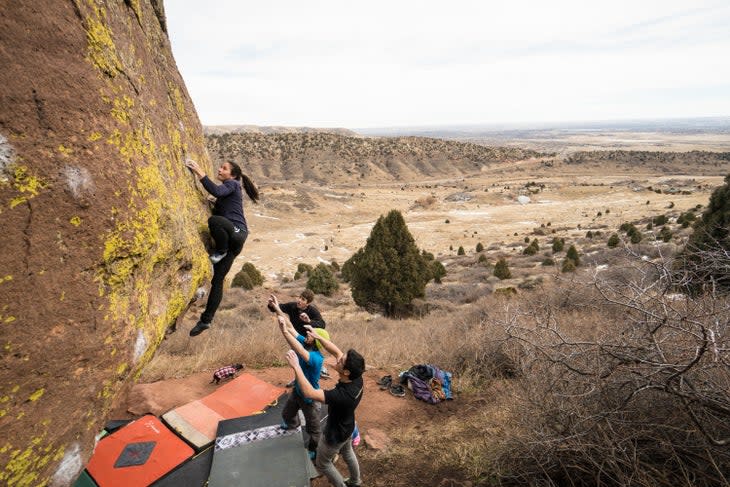Spare Those Ankles! How to Boulder Safely
This article originally appeared on Climbing
Fifteen feet above the ground, I zeroed in on the last hard move of Evilution Direct (V11 very highball) in Bishop, California. I pounced for a sloping edge, but missed. My heel-hook stayed in place and spun me off the rock. As I fell toward the pads, the ground rushed up in slow motion. My knee began to come toward my face, about to make painful contact. I shifted my body at the last minute and hit the pads feet-first, crumpling onto my back and avoiding a split lip or, worse, a few missing teeth. The fall still hurt, but it could have been worse. This situation is common for boulderers--after all, bouldering is 90 percent falling and 10 percent sending. Falling is something nobody wants to think about, but it happens to everyone. Fear of falling can affect the way we climb, so by making falling a skill to improve upon, we can get good at it and stop letting that fear hold us back while we climb.
Want more? Learn how to boulder your best with our three-part online Boulder Harder, with Nina Williams who lays down the techniques and hard-earned wisdom that have made her one of the world's top boulderers.
Prepare your landing
Before you leave the ground, scope your landing. Arrange the pads so there's no gaps or uneven surfaces. Check for rocks, trees, and spread out gear so as to avoid landing on anything that could hurt you. Predict where you'll land if you fall. Mapping out your trajectory beforehand allows you to prepare your body position for landing, and helps give your spotters an idea of where to stand. There is a real art and a science to prepping the landing zone--don't be so psyched to climb that you rush through this critical step, because chances are you will fall.

Ask for a spot
An extra burst of confidence can come in "handy" if you know you're in good hands. Be clear about where you might need a spot the most, and when you're good without one or with a less attentive one. Communicate with your spotter; make sure she knows where you might come off so she can prepare for your momentum. Also, make sure your spotter knows how to properly catch you and guide your center of gravity toward the pads.
Fall
When you begin falling, look down. Your body will follow your eyes. Zero in on a spot free of obstacles (hopefully you scoped your landing before stepping off the ground!). Make sure to immediately look down every time you fall, whether it's controlled or unexpected. The more you practice looking down, the faster your reaction time will be. A few tips:
Let your spotters know you're coming off with a verbal cue. This prepares them to make sure you land safely and conditions you to get into a "falling mindset."
Instead of bracing for impact, exhale a sharp breath to release additional tension. Try to relax your body as much as possible. The looser your muscles are, the more impact they can absorb without serious injury.
If possible, land on your feet first, but allow your body to crumple. As your legs absorb the impact, roll onto your back. Stabilize with your forearms and elbows--not your hands or wrists. Your torso and backside are bigger surface areas and can take the hit better than your smaller extremities. Avoid sprains by tucking in your limbs.
Practice
Practice falling in your free time. Falling is a skill, much like developing strength and technique. The better you are at falling, the better a climber you'll be. Start by falling in a controlled environment such as the climbing gym. Try falling a short distance, then progress a little higher by one or two handholds. Notice how the differences in height feel. Tuck and roll on your landing and experiment with different body positions
Overcoming your fear
The fear of falling is a completely natural instinct. But what is that 'fear' exactly? When you've prepared your landing, have practiced falling, and are still getting overwhelmed with fear, it's time to make sense of this intangible feeling.
Fear gets into our body as well as our mind. The physical responses are common: increased heart rate, shallow breaths, darting eyes. When you feel fear coming on, think of ways to counteract your physical response. Take a deep breath. Straighten your arms, weight your feet, and relax your posture. Pick one spot on the wall to gaze at instead of looking ahead; this meditative activity will let you slow your thoughts.
Consider your position in the present, not in the future. You haven't fallen yet, so you are still in control of the situation. You have the power to decide whether to continue or to take a deliberate, safe fall. The outcome is in your hands!
Ready to step up your bouldering? Nina Williams and Climbing Magazine have developed two must-take courses for casual and serious boulderers alike:
Intro to Bouldering
Learn how to boulder with our four-part online Intro to Bouldering class, with tips on key equipment, bouldering and spotting safety, and technique, now sale for $30.
Boulder Harder
Take your bouldering to the next level in our 8-part course Boulder Harder, featuring techniques, training, best practices, and tips to make you a problem-crushing machine, now on sale for just $100.
For exclusive access to all of our fitness, gear, adventure, and travel stories, plus discounts on trips, events, and gear, sign up for Outside+ today.

